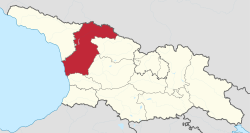Region (mkhare) of Georgia
Mkhare in Georgia
Samegrelo-Zemo Svaneti (Georgian: სამეგრელო-ზემო სვანეთი) is a region (Mkhare) in western Georgia with a population of 308,358 (2021[3]) and a surface of 7,468 km2 (2,883 sq mi).[2] The region has Zugdidi as its administrative center, while Giorgi Guguchia is governor of the region since June 2021.[5][6] Samegrelo-Zemo Svaneti is compiled of the historical Georgian provinces of Samegrelo (Mingrelia) and Zemo Svaneti (i.e., Upper Svaneti).
Subdivisions
The region has one self governing city (Poti) and 8 municipalities with 143 administrative communities (temi),[2] totalling to 531 populated settlements:
Geography
The Samegrelo-Zemo Svaneti Mkhare can be split into two historical regions; Svaneti and Samegrelo. In the northern part of Samegrelo lies the Egrisi Mountains. The municipalities of Chkhorotsqu, Martvili, and Tsalenjikha are located right next to the Egrisi mountain range in Northern Samegrelo. In the south lies the Kolkheti valley, which is a mostly flat region. The municipalities that lie in the valley are Zugdidi, Khobi, Senaki, Abasha, and the city of Poti. The west side of Samegrelo borders Apkhazeti right on the Enguri River and the east borders Imeretion the Tskhenistsqali River. The important Rioni River of West Georgia also passes through Samegrelo, flowing into the black sea in the coty of Poti. The other region; Zemo Svaneti, is located right next to the Northern Caucasus Mountain Range. Its only municipality is Mestia. Svaneti has the tallest mountain in Georgia, Mt. Shkhara, at 5,193 meters, or 17,037 feet.
Demographic
| Population development of the region Samegrelo-Zemo Svaneti[7]
|
|
1959 |
1970 |
1979 |
1989 |
2002* |
2002** |
2014 |
2021
|
| Abasha Municipality |
30,286 |
 30,416 30,416 |
 29,246 29,246 |
 28,219 28,219 |
 28,707 28,707 |
- |
 22,341 22,341 |
 19,560 19,560
|
| Khobi Municipality |
31,280 |
 37,653 37,653 |
 38,092 38,092 |
 38,939 38,939 |
 41,240 41,240 |
- |
 30,548 30,548 |
 27,806 27,806
|
| Martvili Municipality |
47,777 |
 49,167 49,167 |
 47,797 47,797 |
 46,009 46,009 |
 44,627 44,627 |
- |
 33,463 33,463 |
 31,495 31,495
|
| Mestia Municipality |
16,311 |
 17,801 17,801 |
 17,442 17,442 |
 14,776 14,776 |
 14,248 14,248 |
- |
 9,316 9,316 |
 9,447 9,447
|
| City of Poti |
48,117 |
 45,979 45,979 |
 48,508 48,508 |
 50,922 50,922 |
 47,149 47,149 |
- |
 41,465 41,465 |
 41,536 41,536
|
| Senaki Municipality |
47,553 |
 50,336 50,336 |
 50,774 50,774 |
 52,681 52,681 |
 52,112 52,112 |
- |
 39,652 39,652 |
 34,315 34,315
|
| Tsalenjikha Municipality |
29,019 |
 37,813 37,813 |
 39,477 39,477 |
 38,643 38,643 |
 40,133 40,133 |
- |
 26,158 26,158 |
 23,296 23,296
|
| Chkhorotsku Municipality |
27,647 |
 30,784 30,784 |
 31,404 31,404 |
 29,840 29,840 |
 30,124 30,124 |
- |
 22,309 22,309 |
 21,361 21,361
|
| Zugdidi Municipality |
96,643 |
 112,241 112,241 |
 120,217 120,217 |
 125,444 125,444 |
 167,760 167,760 |
- |
 105,509 105,509 |
 99,542 99,542
|
| Samegrelo-Zemo Svaneti |
374,633 |
 412,190 412,190 |
 422,957 422,957 |
 425,473 425,473 |
466,100 |
 416,349 416,349 |
 330,761 330,761 |
 308,358 308,358
|
* Research after 2014 census showed the 2002 census was inflated by 8-9 percent.[8]
**Corrected data based on retro-projection 1994–2014 in collaboration with UN[9]
|
Ethnic groups
According to the Georgian census of 2014,[2] 99.37% of the population is Georgian and 0.35% is Russian. Other ethnic groups living in the region include Ukrainians, Armenians, Abkhazians and Greeks.
Languages
Georgian is spoken by the entire population of the region and by the ethnic minorities like Russians and others.
Mingrelian is a Kartvelian language spoken by the Mingrelians, a sub-group of Georgian people and native to Mingrelia.
Svan is also a Kartvelian language, spoken by the Svans, a sub-group of Georgian people native to Svaneti.
Religion
About 99% of the population identifies as Orthodox Christians. Small minorities of Armenian Christians and Roman Catholics also exist.







